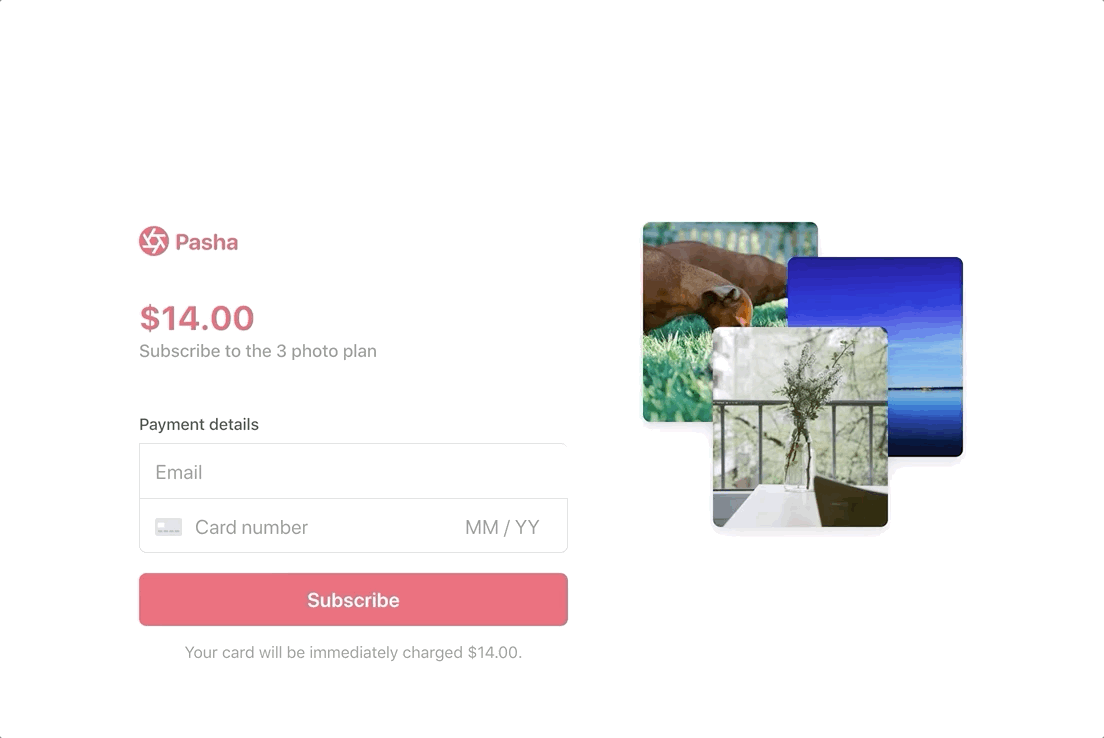This sample shows how to create a customer and subscribe them to a plan with Stripe Billing. You can find step by step directions in the Set up a Subscription guide.
The sample uses Stripe Elements, a web UI library of customizable form fields, to build the UI to collect card details. If you want to set up a subscription page quickly we suggest using Checkout, our prebuilt responsive payment page that comes with Apple Pay & Google Pay and internalization support out of the box.
| Checkout (checkout-subscription-and-add-on) | Elements (this sample) | |
|---|---|---|
| ✨ UI Interface to collect card details | Prebuilt hosted payment page with options to customize limited pieces like the business logo and submit button text | Prebuilt, extremely customizable HTML input elements that securely collect card number, CVC, and exp date |
| 📱 Apple Pay & Google Pay support | Built in, no extra code needed | Requires extra code |
| Does not support coupons | Supports coupons |
You can also see a hosted version of the demo in test mode or fork it on codesandbox.io.

Features:
- Collect card details 💳
- Save a card to a customer
- Subscribe a customer to a plan 💰
This sample includes 7 server implementations in our most popular languages. Follow the steps below to run locally.
1. Clone and configure the sample
The Stripe CLI is the fastest way to clone and configure a sample to run locally.
Using the Stripe CLI
If you haven't already installed the CLI, follow the installation steps in the project README. The CLI is useful for cloning samples and locally testing webhooks and Stripe integrations.
In your terminal shell, run the Stripe CLI command to clone the sample:
stripe samples create set-up-subscriptions
The CLI will walk you through picking your integration type, server and client languages, and configuring your .env config file with your Stripe API keys.
Installing and cloning manually
If you do not want to use the Stripe CLI, you can manually clone and configure the sample:
git clone https://github.com/stripe-samples/set-up-subscriptions
Copy the .env.example file into a file named .env in the folder of the server you want to use. For example:
cp .env.example server/node/.env
You will need a Stripe account in order to run the demo. Once you set up your account, go to the Stripe developer dashboard to find your API keys.
STRIPE_PUBLISHABLE_KEY=<replace-with-your-publishable-key>
STRIPE_SECRET_KEY=<replace-with-your-secret-key>
STATIC_DIR tells the server where the client files are located and does not need to be modified unless you move the server files.
2. Create Products and Plans on Stripe
This sample requires a Price ID to create the subscription. Products and Prices are objects on Stripe that you use to model a subscription.
You can create Products and Prices in the Dashboard or with the API. Create a Price to run this sample and add it to your .env.
3. Follow the server instructions on how to run:
Pick the server language you want and follow the instructions in the server folder README on how to run.
cd server/node # there's a README in this folder with instructions
npm install
npm start
Q: Why did you pick these frameworks?
A: We chose the most minimal framework to convey the key Stripe calls and concepts you need to understand. These demos are meant as an educational tool that helps you roadmap how to integrate Stripe within your own system independent of the framework.
Q: Can you show me how to build X?
A: We are always looking for new recipe ideas, please email dev-samples@stripe.com with your suggestion!